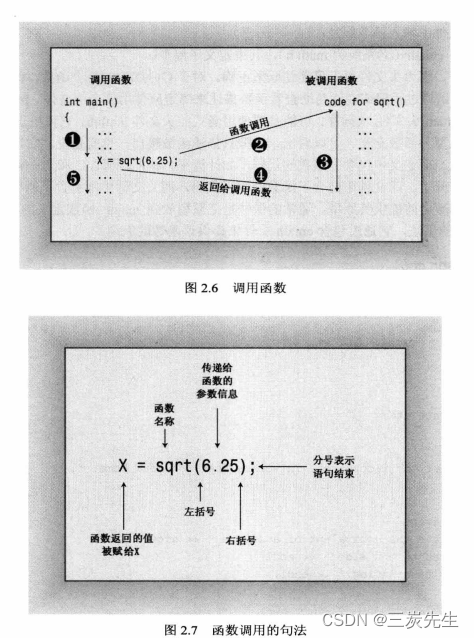2.1 进入 C++
1. 作为接口的函数头
// 格式一
int main(void)
{
return 0;
}
// 格式二
int main()
{
return 0;
}在括号中使用关键词void明确指出,函数不接受任何参数。
2. 为什么 main() 不能使用其他名称
通常,一个 C++ 程序必须包括一个名为 main() 的函数。在运行 C++ 程序时,通常从 main() 函数开始执行。
因此,如果没有 main() ,程序将不完整,编译器将指出未定义 main() 函数。
当然存在一些例外的情况,后续出现再说明。
3. 注释
单行注释://
多行注释:/* */
4. C++ 预处理器
#include <iostream>
using namespace std;iostream 代表文件,io 指的是输入(进入程序的信息)和 输出(从程序中发送出去的信息)。
注意:使用 cin 和 cout 进行输入 和 输出的程序必须包含文件 iostream。
5. 头文件名
像 iostream 这个的文件叫做包含文件(include file)——由于它们被包含再其他文件中;
也叫头文件(head file)——由于它们被包含再文件起始处。
| 头文件类型 | 约定 | 示例 | 说明 |
|---|---|---|---|
| C++ 旧式风格 | 以 .h 结尾 | iostream.h | C++ 程序可以使用 |
| C 旧式风格 | 以 .h 结尾 | math.h | C、C++ 程序可以使用 |
| C ++ 新式风格 | 没有扩展名 | iostream | C++ 程序可以使用,使用 namespace std |
| 转换后的 C | 加上前缀 c,没有扩展名 | cmath | C++ 程序可以使用,可以使用不是 C 的特性,如namespace std |
6. 名称空间
名称空间编译指令来使 iostream 中定义对程序可用:
using namespace std;这个叫 using 编译指令。
名称空间支持时一项 C++ 特性。用于指出使用某个厂商的产品库。
例如:
Microflop::wanda("go dancing?"); // use Microflop namespace version
Piscine::wanda("a fish named Desire"); // use Piscine namespace version按照这种方式,类、函数 和 变量便是 C++ 编译器的标准组件,它们都被放置在名称空间 std 中。
当头文件没有扩展名名 h 时,情况才是如此。
例如:
std::cout << "Come up and C++ me some time.";
std::cout << std::endl;然而,还有其他方法使用 std 名称空间的指定库:
例如:
// using 声明实现
using std::cout;
using std::endl;
using std::cin;
// 空间编译指令 using namespace std
#include <iostream>
int main()
{
using namespace std;
cout << "Come up and C++ me some time.";
cout << endl;
cout <<"You won't regret it!" << endl;
return 0;
}7. 使用 cout 进行 C++ 输出
#include <iostream>
int main(void)
{
using namespace std;
cout << "Come up and C++ me some time.";
cout << endl;
return 0;
}
endl 是一个特殊的 C++ 符号,被称为控制符,表示:重起一行。
endl 也是再头文件 iostream 中定义的,且位于名称空间 std 中。
C++ 还提供一个输出指示换行的旧式方法:\n
cout << "Come up and C++ me some time.\n";
cout << "Come up and C++ me some time." << endl;此外,如果要生成一个空行的话,使用最初的方法比较快捷。
cout << endl;8. C++ 源代码风格
-
每条语句占一行。
-
每个函数都有一个开始 和 结束的花括号。
-
函数中的语句都相对于花括号进行缩进。
-
与函数名称相关的圆括号周围没有空白。
2.2 C++ 语句
1. 声明语句 和 变量
#include <iostream>
int main(void)
{
using namespace std;
int carrots;
carrots = 25;
cout << "I have ";
cout << carrots;
cout << " carrots.";
cout << endl;
carrots = carrots - 1;
cout << "Crunch, crunch. Now I have " << carrots << " carrots." << endl;
return 0;
}2.3 其他 C++ 语句
1. 使用 cin
#include <iostream>
int main(void)
{
using namespace std;
int carrots;
cout << "How many carrots do you have?" << endl;
cin >> carrots;
cout << "Here are two more. ";
carrots = carrots + 2;
cout << "Now you have " << carrots << " carrots." << endl;
return 0;
}用 cin 来读取键盘输入。 符号 << 和 >> 被选择用来指示信息流的方向。
2. 使用 cout 进行拼接
// 方式一:
cout << "Now you have " << carrots << " carrots." << endl;
// 方式二:
cout << "Now you have ";
cout << carrots;
cout << " carrots.";
cout << endl;
// 方式三:
cout << "Now you have "
<< carrots
<< " carrots."
<< endl;2.4 函数
函数分两种:有返回值 和 没有返回值 。
1. 使用有返回值的函数
x = sqrt(6.25); //returns the value 2.5 and assigns it to x函数的变量声明——指出涉及的数据类型。
例如:(实际应用中,采用格式二,尽量去声明变量的数据类型)
// 格式一:
double sqrt(double);
// 格式二:
double x; // declare x as a type double variable
x = sqrt(6.25);在程序中使用 sqrt() 时,也必须提供原型。可以用两种方法来实现:
-
在源代码文件中输入函数原型;
-
包含头文件 cmath (老系统 math.h),其中定义了原型。
#include <iostream>
#include <cmath>
int main(void)
{
using namespace std;
double area;
double side;
cout << "Enter the floor area, in square feet, of your home: ";
cin >> area;
side = sqrt(area);
cout << "That's the equivalent of a square " << side
<< " feet to the side." << endl;
cout << "How fascinating!" << endl;
return 0;
} 2. 自定义函数
步骤:先定义函数体,再 main() 函数里面调用,最后在 main() 函数上面进行函数声明。
// 无返回值
#include <iostream>
void simon(int n);
int main(void)
{
using namespace std;
simon(3);
return 0;
}
void simon(int n)
{
using namespace std;
cout << "Simon says touch your toes " << n << " time." << endl;
}
// 有返回值
#include <iostream>
int stonetolb(int sts);
int main(void)
{
using namespace std;
int stone;
cout << "Enter the weight in stone: ";
cin >> stone;
int pounds = stonetolb(stone);
cout << stone << " stone = ";
cout << pounds << " pounds." << endl;
return 0;
}
int stonetolb(int sts)
{
return 14 * sts;
}注意:关键字不能作他用,只能专用。





















 311
311











 被折叠的 条评论
为什么被折叠?
被折叠的 条评论
为什么被折叠?








